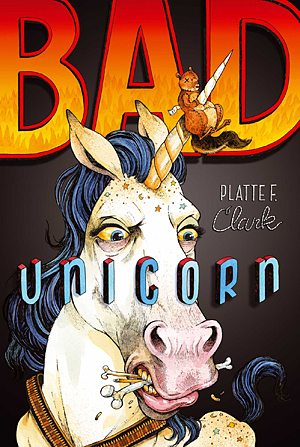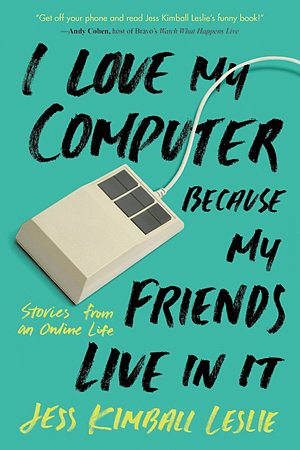
![]()
In this month’s Between the Bookends, Mel explores Russian folklore, Amazonian legend, and killer unicorns, Lisa delves into Norse mythology, and Sophie reminisces on the history of the internet, visits the crazy world of Brexitland, and meets a group of geeky friends who are just too good to be true. We hope you’ll find something to get lost in yourself.
![]()

There might be some truth to the saying “You can’t judge a book by its cover.” Mel Rininger picked up Bad Unicorn by Platte F. Clark for her daughter in the hopes that the 400+ pages would keep her daughter engaged, although secretly Mel was the one who wanted to read it. Unfortunately, Mel’s daughter was not as fascinated with this book, but then again Mel’s daughter enjoys heavy novels like World War Z – she made the mistake of telling her father she was bored, so he gave her the first book within reach.
The story follows Max Spencer, a D & D geek with the ability to read The Codex of Infinite Knowledge, a book that shocks all other users and only shows Max the information it deems necessary. Upon learning that he is the only one who can read The Codex, Max later discovers Princess the Destroyer, a carnivorous unicorn with great magical powers who later turns into a half robot in the future so she can continue her search for the last human, Max. Poor Max must run for his life and find a way to connect with his inner sorcerer to defeat Princess all while saving his friends and making friends with the locals–Frobbits, warrior squirrels, zombie ducks, and other magical creatures.
The overall premise sounds hysterical, on top of the cover art and epic title. However, the writing style is a bit bland for a middle-grade novel and the overall writing is plot driven with simple character descriptions–just enough character development to push the story forward but not enough to engage the reader to feel empathy for the character’s journey from one challenge to the next.
Also, Platte F. Clark uses a great deal of late 80s early 90s references that might get lost on the average middle-grade reader. However, someone like Mel who grew up in that timeframe found the 80/90s references entertaining.
In all honesty, this book would make an amazing adult fantasy novel. However, Clark uses a lot of fantasy elements and then sprinkles elements of sci-fi into the novel which creates a jarring effect on the overall read. Maybe if the author stuck with one major genre and developed the story and characters within those genre guidelines then this novel would be Epic! If anything, the novel is worth a single read just for the snarky comments and geeky references.
![]()

There has been a great deal of conversation across social media about Wonder Woman and her lack of luscious pit-mane in the Wonder Woman trailer. Out of curiosity, Mel Rininger was drawn to Adrienne Mayor’s book The Amazons: Lives and Legends of Warrior Women Across the Ancient World in search of an academic answer to whether Amazonians were depicted with armpit hair, since the basis for said argument is based on whether Wonder Woman is depicted in a believable image of her Amazonian heritage. Also, Mel has never seen a depiction of Wonder Woman with pit-stubble in any of the comics, so the obvious answer was to search for an academic answer.
In her book, Adrienne Mayor challenges the common misconceptions of what we believe to be “fact” about the legend of Amazons and picks apart archeological history from symbolic popular beliefs. This book contains 400+ pages of fascinating evidence pertaining to the Scythian and Thracian women of ancient times, not to mention 100+ pages of source material at the end. There is no shortage of historical imagery depicting Amazons through different artistic medians from paintings to carvings. As a fan of Greek mythology and archeology, Mel was intrigued to discover Mayor’s use of Amazonian myths placed within a historical context and how Mayor debunked many common misconceptions about Amazons.
This book is a must-have for anyone interested in archeology, history, mythology, or for anyone who is just curious about Amazons and the history behind the fierce warrior women that molded the mythology we know and understand today.
![]()

Katherine Arden’s The Bear and The Nightingale came as an Amazon recommendation based on Mel Rininger’s previous book purchases–a habit her husband wishes she would reign in since she buys books the way most women buy shoes.
After reading this poetic pastoral fairytale, Mel was mesmerized by the writing style, characters, and lush imagery. The opening scene is set with an old nursemaid telling Russian folklore to the children of the house; this same tale is woven into the narrative of the protagonist, Vasilisa. As with many fairy tales, there is a common theme of old gods versus new gods. Vasilisa comes from a lineage of witches which allows her to commune with the old gods–gods she spends most of her youth playing with, which is the cause for many of the story conflicts that she must overcome.
The Bear and the Nightingale is the first in what is expected to be an epic trilogy. Katherine Arden’s debut novel is a lyrical narrative weaving together the beautiful Russian countryside with elements of Russian folklore. Mel found herself mesmerized by the writing style and with the way Arden wove together the characters, plot, and fairytale undertone. This was a magical read that kept Mel awake late into the wee hours because she had to know what else could possibly stand in Vasilisa’s path to freedom. If you like character-driven novels with vivid imagery, then this novel comes highly recommended from this GeekMom.
![]()

Lisa already has a collection of books on mythology from the hefty and complex Bulfinch’s Mythology to the more readable and lyrical Tales of Norse Mythology by sisters Annie and Eliza Keary. Neither of these, however, she has found to be the best sources for reading to her youngest daughter, who at seven is just getting interested in these tales. As an avid Neil Gaiman reader, she picked up Gaiman’s new Norse Mythology and found his addictive storytelling perfect for the purpose.
These are simple reinterpretations of the mythology of Odin, Thor, Loki and other Norse gods, so don’t expect any of the American Gods-style deviations from the tales. The more graphic events in the legends, such as how Odin gave his eye to the pool of Mimir, are detailed just enough so the reader still gets the feel of the moment without over-the-top gory details. Keep in mind there are no surprises in these stories. There are no new revelations to be learned from this book for those who are pretty well-versed on Norse legend, but Gaiman’s fantastic and effortless way of spinning tales makes this a great addition to any collection. It is also a wonderful introduction to these characters for young adult readers who want to venture beyond the popular sources like the Marvel Universe or Rick Riordan’s Gods of Asgard series.![]()

Sophie grew up alongside the internet, getting her first computer in the late 90s and taking her first online steps into a world that consisted of USENET groups, chat rooms, and eye-watering animated backgrounds. I Love My Computer Because My Friends Live In It by Jess Kimball Leslie is a book for people who have watched the internet change beside us and watched it change the world as it went. It is also for those fascinated by how those changes came about – the journey from early news features that laughed at the nerds proclaiming that the Internet was the future, to today when we all go about with permanent connections in our pockets or strapped to our wrists, panicking if we have to go even a few hours without access.
The book is something of an internet-focused memoir. It follows Jess from her earliest internet days as a reclusive teenager finding solace in niche chatrooms with like-minded strangers, through the rise and fall of MySpace and Gawker, to the sheer insanity of today’s corporate Twitter marketing. The internet has changed an astonishing amount in the twenty years since it became a household name – the days of dial-up and having to check if anyone was using the phone before we went online seem a lifetime ago. Sophie didn’t feel like she learned much from the book – although she imagines those born even a few years after her might be amazed to read about what “going online” used to be like – however it fed a certain nostalgia in her. The days of the early internet didn’t last long and are its beginnings are likely to only be remembered by those few who dared to take those tentative steps into a brave new world, never realizing just what it would become. You had to be there she supposes.
![]()

The book Sophie most enjoyed this month was One of Us Is Lying, the debut novel from Karen McManus. Described as “The Breakfast Club meets Pretty Little Liars“, this is a book that fits perfectly into the current dark teenage culture of shows like Riverdale and 13 Reasons Why.
The book begins with five teenagers arriving at detention. Bronwyn is a teacher’s pet destined for Yale, Addy is the perfect homecoming princess, Cooper is the school’s all-star baseball pitcher, and Nate is the local criminal who’s already been caught dealing. The fifth student is Simon, creator of About That – an app dedicated to spreading rumors and exposing secrets about the students at their school. But during the few minutes their teacher steps out of the room, Simon suffers an enormous anaphylactic shock and dies. The police discover that someone had put peanut oil into the cups in the room and hidden Simon’s water bottle and epi-pens: this is no tragic accident. Within days, it is revealed that Simon was about to post salacious information about all four of the students in detention with him, information potent enough to ruin their lives for good. However, all four of the others feel that they were planted in the room. Is one of them the murderer, or is someone else behind Simon’s death?
Sophie absolutely loved this story. Although she began to suspect who was behind Simon’s death about two-thirds of the way through, she really enjoyed watching the waves of suspicion roll though the four main characters (the book alternates between the perspectives of all four detention students) bouncing off each one in turn and bringing them together in secret before driving them apart and back again as each new revelation hits. The main characters are more than just their jock, brain, princess, criminal archetypes and have opportunities to develop as the book progresses, although Sophie did figure out the big twist about one of them very, very quickly. This is a great read for anyone who just finished a 13 Reasons Why binge and is wondering how to fill their time until season two rolls around.
![]()

Regardless of your political affiliations, it’s fair to say that the last year or so has been more than a little crazy. Donald Trump is somehow the leader of the free world, Britain is leaving the EU, and over 19 million people watched the former director of the FBI give evidence to the Senate last week. These are bizarre times. Sophie lives in England where multiple elections and the Brexit referendum have plunged the country into a level of uncertainty rarely experienced – anybody watching the British news last Friday would have caught a glimpse of just how bonkers everything seems to have become in Westminster.
Alice in Brexitland by Lucien Young is a parody of the Lewis Carroll classic in which Alice, sick of listening to grownups debating the pros and cons of EU membership, follows David Camerabbit down a hole and into Brexitland where everything is topsy turvy. There she meets the Corbynpillar, Humpty Trumpty, and the Queen of Heartlessness, reads the Daily Murdoch which fills her with so much rage she physically grows in size, and has an encounter with the General Public who “only know things in general and have no grasp of detail”. The world around Alice becomes increasingly out of control, until she eventually wakes up, finding herself back in a sane world where Britain voted to remain in the EU by 99%, Hillary Clinton was elected President, and none of her favorite celebrities died in 2016 – if only we all could be so lucky.
This is not a subtle book and it is one that certainly won’t appeal to Trump or Brexit supporters, neither of whom are caricatured kindly. But for readers who watch the news each night wondering where on Earth all the sane people are hiding, this is a story that will have you nodding your head in agreement at many of the on-the-nose characterisations and wishing that you could indeed wake up and discover that the last year was just a dream after all.
![]()

Sophie also picked up Fingers in The Sparkle Jar, a memoir written by naturalist Chris Packham. Packham is something of a household name in the UK. During Sophie’s childhood he presented the BBC’s The Really Wild Show, a wildlife show aimed at children, and today he presents Springwatch along with other animal documentaries for the BBC. Recently, he has become known for being diagnosed with Asperger’s syndrome later in life and has spoken out about suffering from depression and suicidal thoughts, as well as being a well-known animal rights campaigner.
Fingers in the Sparkle Jar is an odd read. Unlike traditional memoirs, the book frequently shifts perspective with many chapters written in the third person from the viewpoint of people Packham interacted with in his youth: neighbors, classmates, teachers, and even the owner of the local pet shop. Alongside these are shorter chapters written as if by his therapist in recent years, and the more commonplace first-person chapters from Packham’s point of view. This constantly shifting narrative is further confused by the way the book doesn’t proceed in chronological order, instead in skips back and forth through Packham’s youth, giving rise to a mild sense of chaos which is at odds with the young boy’s obsessive orderliness – keeping meticulous notes on everything he discovers and observes in nature.
It’s fair to say that everything about the book paints Packham as an unusual child. Obsessed with all forms of nature, we read about his time spent tracking down birds nests and stealing eggs, checking traps for foxes, and attempting to breed mice to feed the grass snakes he gathered and kept in his garden. He spent most of his young life outdoors in the woods or garden, forever hunting down some new species or training his kestrel – stolen from its nest as a hatchling. His parents seem remarkably tolerant of all this. Sophie wasn’t sure she would be happy to find jars of frogspawn and wild animal skulls all over her son’s bedroom. It isn’t an easy read at times either. Nature is red in tooth and claw after all, and the book doesn’t gloss over this with death and injury a regular feature, often in brutal form. None of that, however, detracts from what was one of those rare things – a truly interesting book, and one that chronicled a type of childhood that Sophie fears may be on the verge of extinction itself.
![]()

Finally, Sophie read the first few installments of Geek Actually, a new serialised story co-written by four female authors (Cathy Yardley, Melissa Blue, Cecilia Tan, and Rachel Stuhler) that blends Sex and The City’s group of close-knit female friends with intense geekdom. The series focuses on five friends. Michelle is senior editor at a publishing company handling sci-fi and fantasy, Aditi is an author at the same company with a deal for the next YA sensation, Taneesha is a coder whose game development company has just been bought out by an industry big fish, Christina works as a PA on the set of a popular TV show, and Elli is more obsessed with making her next cosplay than with actually working a job that might pay for it. The group lives spread out across the USA but keep in touch via a dedicated slack channel and texting.
There’s a lot to love about Geek Actually. The women are diverse in race, sexuality, relationship status, and career choices. They each have their own distinct voice, and the story doesn’t hesitate to show them all standing up and making those voices heard. The story also raises issues that women face in the workplace, especially in often male-dominated geek spheres like publishing and game development. Taneesha’s challenges as a woman of color in the video game industry will almost certainly strike a chord with anyone familiar with the industry’s ongoing issues, while Michelle has to carefully handle a popular author on her roster who is a Gamergater and Men’s Right’s Activist.
All that being said, Sophie found it hard to settle in and enjoy the story for what it was. Certainly, at the beginning, it felt as if the authors were so intent on showcasing their geek credentials that they needed to cram as many geek references into the pages as they could. Within only a few pages, io9, Jezebel, Bustle, Den of Geek, Felicia Day and the Vaginal Fantasy book club had all been namechecked (although admittedly all as part of a rant from a minor character), and it didn’t take long for World of Warcraft, Doctor Who, Frank Miller, Pokemon Go, My Little Pony, Star Wars and Gishwhes to get a mention – there’s even a Hamilton line thrown in for good measure. The characters struggled to feel real. Instead, they felt like robots built to appeal to adult geek women, as if the teenage boys in Weird Science had been replaced by an adult geek woman looking to build herself a group of friends rather than a wet dream made flesh. Once the story had settled down a bit, these issues weren’t quite so prominent, but the book still seemed overly concerned with forcefully pointing out how geeky these women’s lives are. “Look, the boss has a TARDIS and a signed picture of the boys from Supernatural in her office! She’s such a geek!” It was all just a touch heavy-handed.
Geek Actually is being released as a serial consisting of 13 parts (referred to as episodes), each around 50-70 pages long which will make it easy to pick up and dip into when you have a short amount of time. For those interested in trying it out, a sample of part/episode one is available on the Serial Box website and each new episode is released on a Wednesday, with episode two released yesterday. Sophie will be continuing with the series, for now, hoping that the characters can shake off their Stepford Geek Friend personas and start being a bit more believable.



